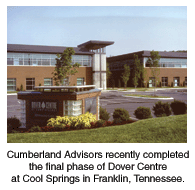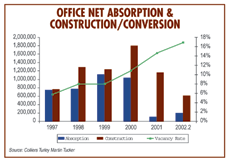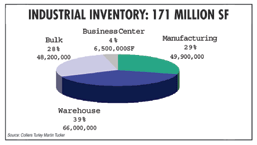NASHVILLE EMBARKS ON ROAD TO RECOVERY
Ben Blakeley
For the second consecutive quarter, the Nashville, Tennessee, office
market experienced modest occupancy growth as roughly 240,000 square feet
of net absorption was posted for the third quarter of 2002. A slight pick-up
in leasing activity caused the overall vacancy rate to decline to 15.8
percent — down from 16.8 percent at mid-year. While occupancy growth
in any form during turbulent times is good news, it is by no means indicative
of a market that is stabilizing and in store for an imminent recovery.
Recent indicators on both the local and national level reveal that market
conditions may take longer to improve than previously expected.
Over the last few months, however, a few other bright spots have emerged.
At the beginning of 2001, the first of several waves of sublease office
space flooded the local market. During the first three quarters of 2002,
sublease inventories declined by nearly 10 percent, which bodes well for
the Nashville market. Much of the recent occupancy growth has been due
in large part to tenants taking advantage of the below-market offerings
of sublease space and increased competition among landlords. A limited
pool of lease prospects has prompted building owners to become more aggressive
in structuring deals by offering generous build-out allowances, free rent
and moving allowances. The amount of concessions offered generally depends
on the length of the term, the submarket and tenant credit.
 At
the end of 2002, only two new projects, totaling approximately 175,000
square feet, were completed. Burton Hills IV, a 135,000-square-foot Class
A building in the Green Hills submarket, was developed by Alex Palmer.
The building came on line during the fourth quarter at 56 percent occupancy.
The final phase of Cumberland Advisor’s Dover Centre at Cool Springs,
a 40,000-square-foot, Class A building in Franklin, was also completed. At
the end of 2002, only two new projects, totaling approximately 175,000
square feet, were completed. Burton Hills IV, a 135,000-square-foot Class
A building in the Green Hills submarket, was developed by Alex Palmer.
The building came on line during the fourth quarter at 56 percent occupancy.
The final phase of Cumberland Advisor’s Dover Centre at Cool Springs,
a 40,000-square-foot, Class A building in Franklin, was also completed.
The Brentwood/Cool Springs submarket remains the focal point for leasing
and development activity in the Nashville office market. Steady leasing
activity since the first quarter has brought the overall vacancy rate
down from 20.2 to 17.3 percent. Similarly, the total amount of sublease
space has also fallen from the high-water mark of 372,000 square feet
set in the first quarter to the current level of 279,000 square feet.
Overall third quarter net absorption for the Brentwood/Cool Springs submarket
was 94,000 square feet.
The Class A market in Brentwood/Cool Springs continues to outperform its
counterparts in other submarkets, as occupancy has increased by 126,000
square feet over the last 6 months. This is a positive sign for one of
the city’s strongest submarkets. After adding more than 1 million
square feet of new product in 2001, which increased the vacancy rate to
20.2 percent at the beginning of the year, steady leasing activity has
brought it down to 17.3 percent.
 Despite
two straight quarters of occupancy growth, the office market remains soft
and should continue to show signs of pressure from the current recession.
The overall vacancy rate of 15.8 percent for the Nashville market closely
mirrors that of the national office vacancy rate, which stood at 15.7
percent at mid-year. Sublease space for the entire market totals 853,000
square feet, or 20 percent of all available space, and will continue to
be problematic. Fortunately, a slowdown in construction will help somewhat,
and an always active and entrepreneurial healthcare sector should continue
to be a major contributor to occupancy growth in the near future. Despite
two straight quarters of occupancy growth, the office market remains soft
and should continue to show signs of pressure from the current recession.
The overall vacancy rate of 15.8 percent for the Nashville market closely
mirrors that of the national office vacancy rate, which stood at 15.7
percent at mid-year. Sublease space for the entire market totals 853,000
square feet, or 20 percent of all available space, and will continue to
be problematic. Fortunately, a slowdown in construction will help somewhat,
and an always active and entrepreneurial healthcare sector should continue
to be a major contributor to occupancy growth in the near future.
Leasing activity is expected to stay slow but tenant interest should remain
strong as users consider taking advantage of attractive lease rates currently
being offered by landlords. The market presently lacks sufficient demand
to warrant any new developments in the near future.
Industrial
After displaying strong growth in 2001 and the first quarter of 2002,
the Nashville industrial market has begun to feel the effects of the sluggish
national economy. Vacancy rates continued their upward trend in the third
quarter as the local market experienced an overall lack of demand. Growing
inventories of available and vacant space have only compounded the current
situation, making for a very competitive leasing environment. Sales activity,
on the other hand, has been strong as of late with users seeking to take
advantage of low interest rates. Nashville also continued to see a great
deal of investment activity and interest on behalf of private and institutional
investors during the third quarter as well. The area’s diverse economy,
strong tenant base and locational advantage will continue to earn the
attention of investors from across the country, as more and more investment
money looks for purchase opportunities outside of the top tier markets.
Conditions in the mid-state still reflect considerable market uncertainty
as evidenced by numerous local indicators. Downsizing and plant closings
have been largely to blame for the market’s declining occupancy levels,
which experienced nearly 1 million square feet of negative net absorption
in the third quarter. After posting a modest 125,000 square feet of occupancy
growth in the first quarter of the year, overall occupancy decreased by
nearly 2.3 million square feet over the second and third quarters. Consequently,
the overall vacancy rate rose from 5.2 to 6.7 percent over the same period
of time. Meanwhile, construction completions are off from 2001’s
numbers, which is actually good news for the local market.
 Third
quarter completions totaled approximately 542,000 square feet, which represents
an 85 percent drop from construction totals in the third quarter of 2001.
With supply continuing to far outweigh demand, speculative construction
starts should remain on hold until more favorable market conditions arise.
The only building to come on line in the third quarter was Genesco’s
325,000-square-foot build-to-suit distribution center off Highway 109
in the East Market. The fourth quarter saw the majority of the remaining
2.2 million square feet delivered. Fortunately, most of that space was
pre-leased, build-to-suit activity. These completions should boost Nashville’s
total industrial inventory to over 173 million square feet. Third
quarter completions totaled approximately 542,000 square feet, which represents
an 85 percent drop from construction totals in the third quarter of 2001.
With supply continuing to far outweigh demand, speculative construction
starts should remain on hold until more favorable market conditions arise.
The only building to come on line in the third quarter was Genesco’s
325,000-square-foot build-to-suit distribution center off Highway 109
in the East Market. The fourth quarter saw the majority of the remaining
2.2 million square feet delivered. Fortunately, most of that space was
pre-leased, build-to-suit activity. These completions should boost Nashville’s
total industrial inventory to over 173 million square feet.
The East Market area remains the hot spot in the local market as well
as the focal point for new construction. As mentioned earlier, the new
325,000-square-foot Genesco building was completed in the third quarter.
Genesco was part of a group of companies that have decided to relocate
their distribution operations to the emerging East Market. Bridgestone/
Firestone later followed suit by breaking ground on a new 750,000-square-foot
distribution center with expansion up to 1 million square feet. Panattoni
Development was awarded the development of this project. Since then, ProLogis
has kicked off construction on a 301,000-square-foot build-to-suit for
Falken Tire on one of the last sites inside Eastgate Business Park. Falken
currently occupies 250,000 square feet in Space Park South, a large industrial
park owned by ProLogis.
Hope that the current recession would be shallow and short-lived has waned
over the last couple of months, as economic recovery has lost some of
its momentum. What type of bearing this will have on the local industrial
market remains to be seen. Local market indicators tend to reveal a continued
lack of demand for industrial product, especially within the historically
strong bulk market. Speculative construction will be kept to a minimum
to allow for absorption of excess supply. Demand-driven construction will,
however, continue through the remainder of the year. Rental rates should
continue to trend downward given the amount of available and vacant space
on the market. There appears to be a number of companies planning for
growth and expansion once they can see past the current economic outlook.
Investment
Investment activity and interest picked up in the Nashville area during
the third quarter of 2002. A number of high-profile properties changed
hands during 2002 in what was a busy year for real estate investors.
Notable industrial investment deals include New York-based American Real
Estate Holdings’ purchase of the 520,000-square-foot Mid-South Logistec
V for slightly over $18 million, or roughly $34.80 per square foot, and
Pinchal & Company’s purchase of Northfork Industrial Park, which
comprises three bulk buildings totaling 301,500 square feet, for $9.5
million or $31.51 per square foot. Significant office investment sales
include Eakin Partners’ purchase of Burton Hills I & II, which
total 230,000 square feet, for close to $25 million, or $108 per square
foot, and Vanderbilt University’s purchase of the 106,000-square-foot
Crystal Terrace building for $12.4 million.
Retail
While the office and industrial markets across the country have seen vacancies
rise throughout the current recession, retail properties have not been
as hard hit. Despite a less than favorable economic setting, activity
in the Nashville retail market remained relatively strong through 2002.
Lower interest rates and zero financing for automobiles has helped maintain
consumer spending, while strong population growth in the suburban areas
around Nashville has led to continued activity on the part of large retailers
such as Kohl’s and Lowe’s. Rutherford and Williamson counties,
which have experienced population growth exceeding 50 percent over the
last decade, have been the recipients of much of the new construction.
Over the last 7 years, nearly 10 million square feet of retail space has
been developed in the Cool Springs area. This submarket should continue
to receive the most attention from national retailers.
Albertsons departure from the local market has opened the door for other
grocery operations looking to establish a presence in Nashville. Wal-Mart
will open the first of its new neighborhood grocery concept in the Nipper’s
Corner area in a space previously occupied by Albertsons. The retail giant
is also close to starting two additional projects in the Nashville area
in the coming months. The demise of Albertsons has marked the entry of
Publix into Middle Tennessee; Publix plans to open more than 30 stores
in the mid-state area. The supermarket operator has already opened new
stores in Hermitage and Franklin.
Overall, the outlook for retail space in Nashville remains bright. With
national retail operations continuing to increase their presence in the
Nashville area, the retail market should carry over much of that momentum
into 2003. The ongoing recession will perpetuate the “discount”
mentality that has pervaded the collective conscience of consumers as
of late and keep buyers more cost-conscious than in years past.
Ben Blakeley is director of research with Colliers Turley Martin Tucker.
©2003 France Publications, Inc. Duplication
or reproduction of this article not permitted without authorization
from France Publications, Inc. For information on reprints of
this article contact Barbara
Sherer at (630) 554-6054.
|
